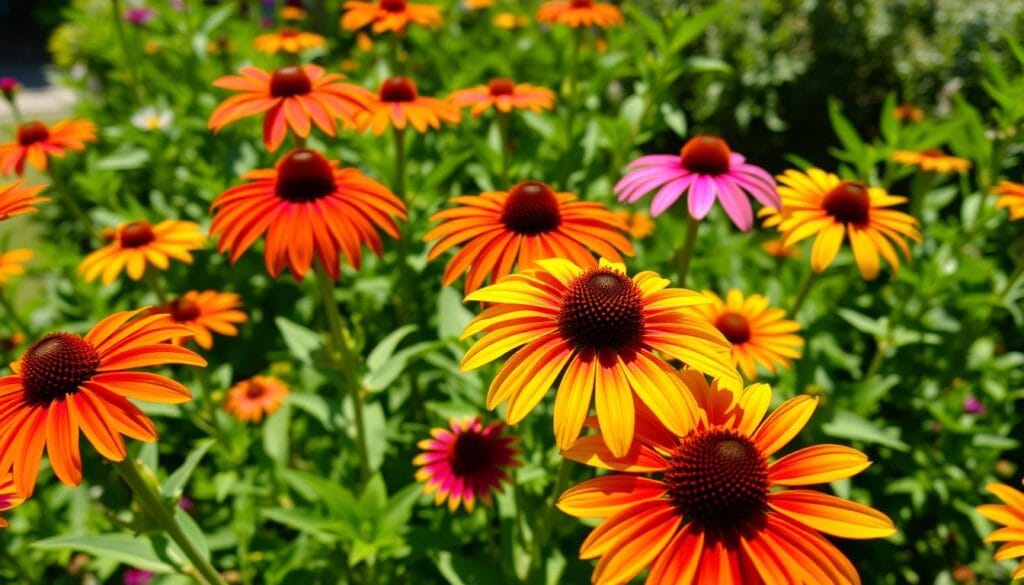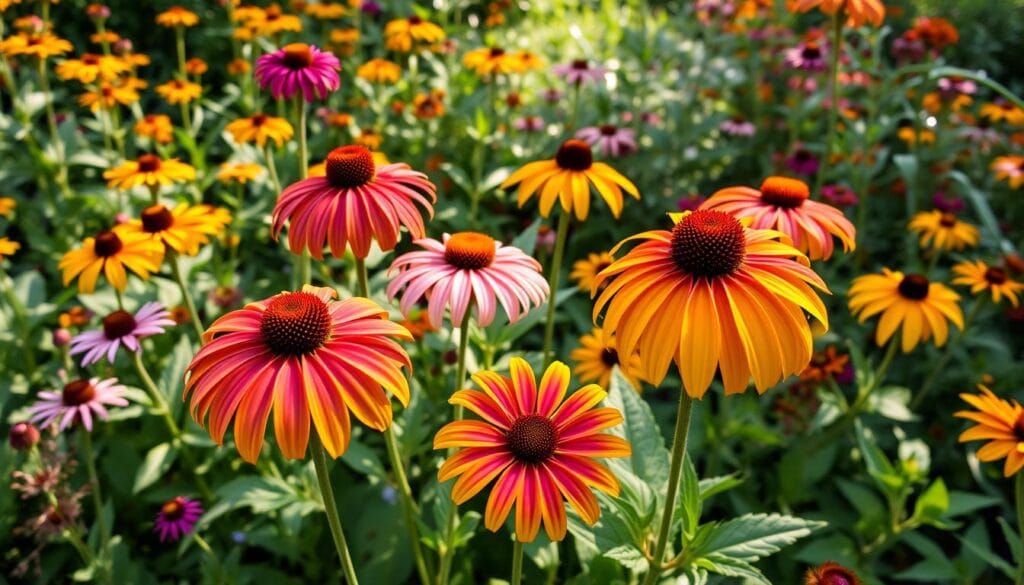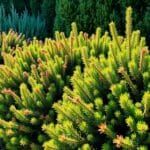Did you know coneflowers can bloom for up to 5 months? They add vibrant colors to gardens from May to September. This makes them a top choice for gardeners looking for long-lasting beauty. As a native wildflower of North America, coneflowers have won the hearts of many with their resilience and charm.
Coneflowers are easy to grow in different conditions. They thrive in USDA zones 3-9 and can handle rocky, clay, or sandy soils. Their ability to resist drought means less work for gardeners of all levels.
The purple coneflower is just one of about 40 varieties by Monrovia craftsmen. These varieties offer a wide range of colors and growth habits. This ensures there’s a perfect coneflower for every garden.
Echinacea is more than just a pretty flower. It has medicinal properties that have been valued for centuries. Plus, its blooms attract pollinators, making your garden a lively place.
Key Takeaways
- Coneflowers bloom for up to 5 months, from May to September
- Native to North America, thriving in USDA zones 3-9
- Drought-resistant and adaptable to various soil types
- Available in about 40 varieties with diverse colors and forms
- Attracts pollinators and has medicinal properties
- Requires 6-8 hours of daily sun for optimal growth
- Low-maintenance perennial that returns year after year
Introduction to Coneflower (Echinacea)
Coneflower, also known as Echinacea, is a favorite in many gardens across the United States. It’s a vibrant perennial that gardeners and nature lovers adore.
Native North American Wildflower
Echinacea purpurea, or purple coneflower, is a top choice for native perennials in the U.S. It grows well in zones 3-8, fitting many climates. First found in 1699, it became popular in European gardens by 1895.
Characteristics and Varieties
Coneflowers are 2 to 5 feet tall and 1-1/2 to 2 feet wide. They bloom from June to August, showing off a range of colors. You can find them in purple, pink, red, orange, white, yellow, and even green.
Benefits for Gardens and Ecosystems
Coneflower is key to local ecosystems as a native plant. It attracts bees, butterflies, and birds, making your garden a wildlife haven. It’s also easy to care for and has medicinal uses. Species like E. purpurea, E. angustifolia, and E. pallida are used in herbal remedies.
| Characteristic | Description |
|---|---|
| Sunlight Requirement | Full sun (6+ hours daily) |
| Soil pH Preference | 6 to 7 |
| Water Needs | 1-2 inches per week |
| Bloom Time | June to August |
| Wildlife Attracted | Bees, butterflies, birds |
Growing Conditions and Care
Coneflowers are a gardener’s dream, thriving in full sun and well-draining soil. These hardy perennials are native to North America and belong to the daisy family. They bring vibrant colors to our gardens from mid-summer until frost.
Ideal Sunlight and Soil Requirements
For optimal growth, coneflowers need 6-8 hours of direct sunlight daily. They adapt well to various soil types but prefer well-draining, slightly alkaline soil with a pH between 6.5 and 7.0. These drought-tolerant beauties can handle poor soil conditions, making them perfect for raised flower beds.

Watering and Fertilizing Techniques
Coneflowers are low maintenance once established. In their first year, water them every other day when the top inch of soil feels dry. After that, they only need watering during extended dry spells. Fertilizer isn’t necessary if you’ve planted them in nutrient-rich soil. A spring mulch with compost is usually enough to keep them happy.
Pruning and Maintenance Tips
To encourage continuous blooming, deadhead spent flowers regularly. In late winter, cut back the stems to promote new growth. For bushier plants, prune them to about 30 inches tall in June. This technique can also delay blooming, extending the overall flowering period in your garden.
| Care Aspect | Requirement |
|---|---|
| Sunlight | 6-8 hours daily |
| Soil pH | 6.5 – 7.0 |
| Watering (Established) | Only during drought |
| Fertilizer | Spring compost mulch |
Coneflower (Echinacea) Varieties and Colors
Coneflowers, or echinacea varieties, come in many colors beyond the classic purple. We’ve looked at different types that add vibrant colors to gardens in the United States.
Purple is still a favorite, with ‘PowWow Wild Berry’ being a big hit. It won an All-America Selection in 2010. This variety blooms all summer without needing to be deadheaded, making it easy to care for and beautiful.
‘Leilani’ from the Prairie Pillars Series grows very tall, reaching 36 to 42 inches. Its height adds depth to gardens.
‘Intense Orange’ from the Kismet Series is a standout with its multi-tone blooms. They range from deep orange to rich pumpkin. It’s great for adding warmth to gardens.
‘Green Envy’ starts green and then turns magenta around the center cone. This change makes it interesting to watch all season.
| Variety | Height | Width | USDA Zones | Bloom Time |
|---|---|---|---|---|
| Purple Coneflower | 2-5 feet | 1-2 feet | 3-8 | Summer |
| ‘Cheyenne Spirit’ | 12-30 inches | 18-20 inches | 4a-9a | Summer-Fall |
| ‘Tennessee Coneflower’ | 1.5-2 feet | 1-1.5 feet | 5-8 | Summer |
| Sombrero ‘Adobe Orange’ | 18-26 inches | 18-24 inches | 4-9 | Summer-Fall |
| ‘Pow Wow White’ | 18-24 inches | 12-18 inches | 3-9 | Early Summer-Fall |
Coneflowers come in colors like white, pink, yellow, and even green. There’s a type for every garden. They grow well in zones 3 through 9, depending on the variety.
Landscape Design with Coneflowers
Coneflowers are great for any garden, adding color and texture. They’re perfect for both formal and natural gardens. Let’s look at some ways to use coneflowers in your garden.
Companion Planting Ideas
Choosing the right plants to go with coneflowers can make your garden pop. Here are some top picks:
- Black-Eyed Susans
- Goldenrods
- Native grasses like Little Bluestem
- Butterfly bushes
- Sneezeweed (Helenium)
For more color, add annuals like marigolds or sun-loving coleus. These plants bloom all season, making your garden vibrant.

Creating Pollinator Gardens
Coneflowers are a hit with pollinators. Their bright colors and nectar attract bees, butterflies, and hummingbirds. Plant them in groups for a colorful spot for these visitors.
Using Coneflowers in Borders and Beds
In borders and beds, coneflowers add height and structure. Plant them in swaths for a bold look, or use them as vertical elements. They’re great for sunny spots and grow well in zones 4 through 9.
Remember, coneflowers need well-draining soil and full sun. Don’t pair them with plants that like wet soil, like swamp milkweed. Instead, choose drought-tolerant plants like sedum for a garden that’s easy to care for.
Seasonal Interest and Bloom Time
Coneflowers add beauty to gardens all year. Their summer blooms are full of color, attracting bees and butterflies. In Central Texas, they start blooming in mid-April and last until early June.
When summer gets hot, the flowers fade. But don’t worry, they bloom again in September.
Fall brings a new look as the flowers turn into seed cones. These seed cones add texture and interest to the garden. In winter, the seed heads provide food for birds like goldfinches.
Here’s a breakdown of coneflower activity throughout the year:
| Season | Plant Activity | Garden Interest |
|---|---|---|
| Spring | New foliage emerges, bloom stalks form | Fresh green growth |
| Summer | Peak flowering period | Vibrant blooms, pollinator attraction |
| Fall | Second bloom cycle, seed head formation | Late flowers, textural interest |
| Winter | Dormancy, occasional blooms in mild weather | Seed heads for birds, structural element |
Coneflowers are great because they can handle different conditions. They love full sun and well-draining soil but also do well in partial shade. Pair them with plants that bloom in late summer and fall for a garden that’s always colorful and interesting.
Medicinal Properties and Uses
Coneflower, or Echinacea, has been a key part of herbal medicine for centuries. It’s known for its natural health benefits. Let’s look at how it’s used today and in the past.
Traditional Herbal Remedies
Native Americans valued Echinacea for its healing powers. They used it for many health issues, from wounds to breathing problems. This history has led to its use in modern medicine.
Modern Health Applications
Now, Echinacea is seen as a great immune booster. Many take echinacea supplements when they’re sick. Studies show it can cut the chance of getting sick by up to 22%. It’s also used for chronic pain and skin problems because of its anti-inflammatory effects.
Harvesting and Preparation Methods
To use Echinacea’s health benefits, it must be harvested and prepared carefully. The roots, leaves, and flowers are used in different ways. Here are some common ways to prepare it:
| Preparation Method | Parts Used | Common Uses |
|---|---|---|
| Tea | Dried leaves and flowers | Immune support, sore throat relief |
| Tincture | Roots and aerial parts | Cold and flu prevention, anti-inflammatory |
| Capsules | Powdered plant material | General immune support, convenience |
| Topical Ointment | Extracted plant compounds | Skin conditions, wound healing |
While Echinacea has many benefits, it’s important to talk to a doctor before taking it. Some people might have allergies or reactions with medicines. Knowing how to use it safely can help us benefit from this amazing plant. For more on great garden plants with health benefits, check out our guide.
Conclusion
We’ve looked into the amazing world of coneflowers. They are a favorite in gardens, bringing beauty and benefits. These perennials have been loved by gardeners for centuries, since their discovery in 1699.
Native to North America, Echinacea purpurea is a key part of many gardens. It grows well in zones 3-8. This makes it a great choice for many gardeners.
Coneflowers are easy to care for but offer a lot. They need full sun and well-drained soil. Once they’re established, they can handle drought.
Their bright flowers attract pollinators, showing their ecological value. With colors ranging from classic purple to vibrant hues, there’s a coneflower for every garden.
Beyond their beauty, coneflowers have medicinal uses. Studies have found they have antioxidant and antimicrobial properties. This supports their use in traditional medicine.
As we learn more about coneflowers, they will continue to be a favorite in gardens. They offer beauty and health benefits for years to come.
FAQ
What are the ideal growing conditions for coneflowers?
How can I use coneflowers in my landscape design?
What are the benefits of growing coneflowers?
What colors and varieties of coneflowers are available?
How can I use coneflowers for their medicinal properties?
When do coneflowers typically bloom?
Source Links
- Coneflower Care Guide: How to Plant, Grow, and Design with Echinacea
- Coneflower – The Ultimate Guide to Growing Echinacea Plants
- Echinacea Explosion – The Coneflower Chronicles
- Coneflower Care: Planting & Growing Echinacea Flowers – Garden Design
- How to Grow Coneflowers: The Complete Echinacea Flower Guide
- Growing Echinacea: How to Grow Echinacea Plants | American Meadows
- Coneflower Care Guide: How to Plant, Grow, and Design with Echinacea
- 35 Stunning Types of Coneflowers for Your Garden
- Seven of Our Favorite Echinacea Varieties
- 23 Different Types of Beautiful Coneflower Varieties
- Top 10 coneflower landscaping ideas and inspiration
- Coneflower Companion Plants | Plant Addicts
- Purple Coneflower (Echinacea purpurea): A Seasonal Look
- Purple Coneflower (Echinacea Purpurea): An Early Spring Emerging, Summer Blooming Wildflower
- Echinacea: Benefits, Uses, Side Effects, and Dosage
- PURPLE CONEFLOWER
- Echinacea Information | Mount Sinai
- Echinacea Explosion – The Coneflower Chronicles
- Echinacea purpurea (L.) Moench: Biological and Pharmacological Properties. A Review


